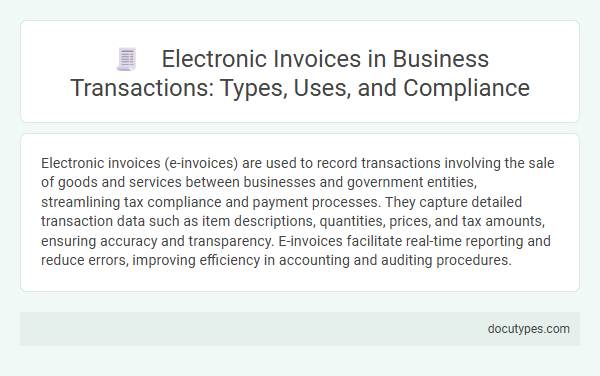Electronic invoices (e-invoices) are used to record transactions involving the sale of goods and services between businesses and government entities, streamlining tax compliance and payment processes. They capture detailed transaction data such as item descriptions, quantities, prices, and tax amounts, ensuring accuracy and transparency. E-invoices facilitate real-time reporting and reduce errors, improving efficiency in accounting and auditing procedures.
Introduction to Electronic Invoices in Business Transactions
Electronic invoices (e-Invoices) record sales and purchase transactions digitally, streamlining business processes. These digital documents replace traditional paper invoices, ensuring faster and more accurate transaction management.
You can use e-Invoices for various transactions, including goods sales, service provisions, and inter-company billing. E-Invoices improve compliance with tax regulations and enhance transparency in financial reporting. This technology supports real-time data exchange between businesses and tax authorities, reducing errors and fraud risks.
Key Features of Electronic Invoicing Systems
Electronic invoices (e-Invoices) are used to record transactions such as sales, purchases, and service agreements, ensuring accurate and compliant financial documentation. Key features of electronic invoicing systems include automated data capture, real-time validation, and secure digital storage to enhance efficiency and reduce errors. Your business benefits from faster processing times and improved transparency through streamlined e-Invoice management.
Main Types of Electronic Invoices
Electronic invoices (e-invoices) are primarily used to document sales and purchase transactions in digital format. These e-invoices replace traditional paper invoices, enabling faster and more accurate record-keeping.
The main types of electronic invoices include standard e-invoices, credit notes, and debit notes. Standard e-invoices record typical sales transactions, while credit and debit notes adjust previously issued invoices for returns or additional charges.
Workflow and Lifecycle of an Electronic Invoice
Which transactions are recorded using electronic invoices (e-Invoices)? Electronic invoices document sales and purchase transactions digitally, ensuring accuracy and compliance. They streamline the billing process from issuance to payment confirmation.
How does the workflow of an electronic invoice operate? The workflow initiates with invoice creation, followed by automated validation, electronic transmission, and recipient acknowledgment. This process reduces errors and accelerates transaction cycles.
What is the lifecycle of an electronic invoice? The lifecycle includes creation, approval, sending, receipt, payment processing, and archiving. Each stage is tracked electronically to ensure transparency and audit readiness.
Which key benefits result from using e-Invoices in transaction recording? E-Invoices enhance data security, improve operational efficiency, and facilitate regulatory compliance. They enable real-time transaction monitoring and reduce manual processing time.
Business Benefits of Using Electronic Invoices
Electronic invoices (e-Invoices) are used to record sales transactions, purchase orders, and service agreements. These digital documents replace traditional paper invoices to streamline financial processes and enhance record accuracy.
- Enhanced Efficiency - E-Invoices speed up transaction processing by automating data entry and reducing manual errors.
- Cost Reduction - Businesses save on printing, postage, and storage costs associated with paper invoices.
- Improved Compliance - E-Invoicing facilitates adherence to tax regulations through standardized digital reporting and audit trails.
Electronic Invoice Standards and Formats
Electronic invoices (e-invoices) record a wide range of commercial transactions to ensure accuracy and compliance. These invoices utilize standardized formats to streamline data exchange between business entities.
- Standardized XML Format - e-Invoices commonly use XML-based formats to facilitate seamless data integration with accounting systems.
- Compliance with National Regulations - Transactions recorded via e-invoices adhere to country-specific legal and tax requirements, ensuring their validity.
- Real-time Transaction Recording - Electronic invoices enable immediate documentation of sales, purchases, and service transactions for faster processing.
Your transactions benefit from consistent electronic formats that enhance transparency and reduce errors.
Legal and Regulatory Compliance for E-Invoicing
Electronic invoices (e-invoices) document transactions that meet specific legal and regulatory requirements. These records are essential for maintaining compliance with tax authorities and government regulations.
- Mandatory E-Invoicing Transactions - Transactions involving registered taxpayers often require e-invoice issuance to ensure traceability and auditability.
- Tax Compliance Verification - E-invoices facilitate real-time verification of transaction data by tax authorities, reducing fraud and errors.
- Regulatory Data Retention - Legal frameworks mandate that e-invoices are stored securely for a specified period to support audits and reporting obligations.
Industry-Specific Applications of Electronic Invoicing
Electronic invoices (e-Invoices) are recorded for transactions involving the sale of goods and services across various industries, including retail, manufacturing, and healthcare. These transactions require accurate and compliant documentation to ensure tax reporting and auditing processes are streamlined.
In the automotive industry, e-Invoices track parts supply and service transactions efficiently, while the real estate sector uses e-Invoices for lease payments and property sales. The logistics sector benefits by recording freight and shipping services digitally, enhancing transparency and operational efficiency.
Common Challenges and Solutions in E-Invoicing Adoption
Electronic invoices (e-invoices) typically record business-to-business (B2B) and business-to-government (B2G) transactions, ensuring accuracy and legal compliance. Common challenges in e-invoicing adoption include integration with existing accounting systems, data security concerns, and regulatory complexity across different regions. Solutions involve leveraging standardized e-invoicing platforms, implementing robust encryption methods, and engaging with regulatory bodies for seamless compliance.
Which Transactions Are Recorded Using Electronic Invoices (e-Invoices)? Infographic

